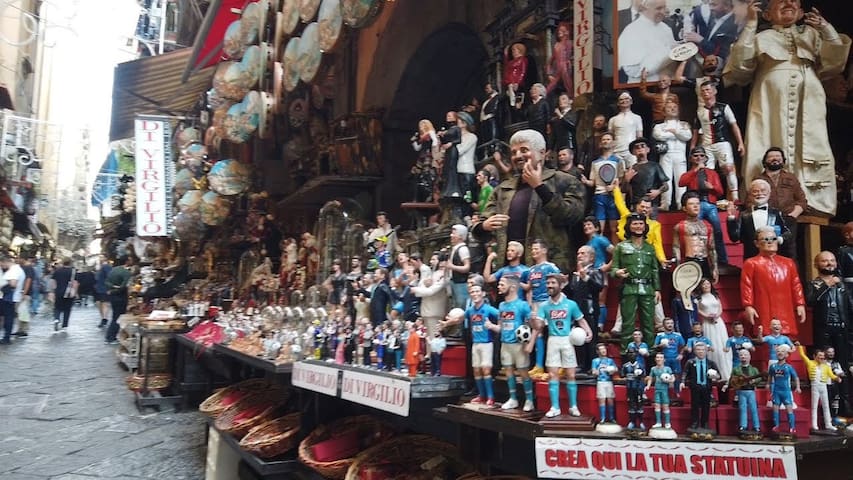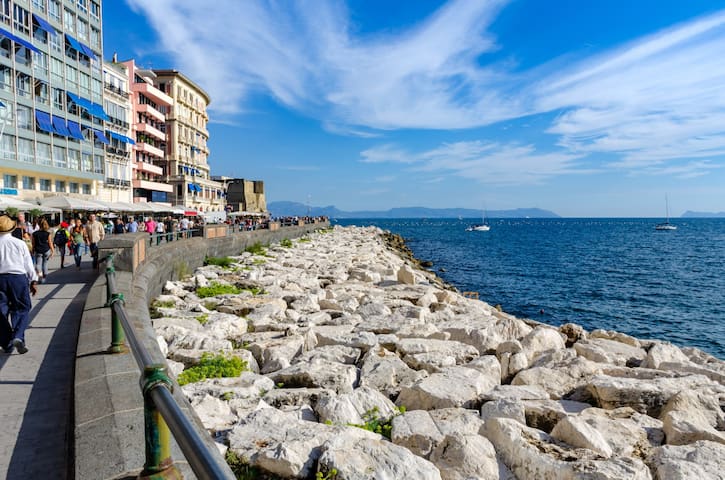Visite turistiche
Placed at the centre of the nave of Chapel the Veiled Christ in one of the most famous and impressive works of art in the world
1008 yerel halk öneriyor
Sansevero Şapel Müzesi
19/21 Via Francesco de SanctisPlaced at the centre of the nave of Chapel the Veiled Christ in one of the most famous and impressive works of art in the world
It is a Roman Catholic cathedral, the main church of Naples. It is widely known as the Cattedrale di San Gennaro, in honour of Saint Janarius, the city's patron saint. It is famous also for the Miracle of blood and the Museum of Treasury of the Saint Janarius
313 yerel halk öneriyor
Santa Maria Assunta Katedrali
147 Via DuomoIt is a Roman Catholic cathedral, the main church of Naples. It is widely known as the Cattedrale di San Gennaro, in honour of Saint Janarius, the city's patron saint. It is famous also for the Miracle of blood and the Museum of Treasury of the Saint Janarius
The cloister of the Monastery of Santa Chiara, founded in 1310, looks more like a park in a seaside resort town than a solemn retreat for nuns. Majolica tiles made at the Capodimonte workshops, in vivid colors and lively designs, cover the 66 octagonal columns surrounding its cloister, and between the columns are long benches also covered in tiles. These seem to bring the secular world inside the monastery walls, with scenes from everyday life of their period—the mid-1700s. Under the porticos, the walls on all four sides of the cloister are covered with 17th-century frescoes of Old Testament scenes.
Inside on the right is a presepio (Nativity scene) set in a Roman ruin, incorporating mundane daily Neapolitan life along with the sacred creche scene. The figures are dressed in typical local 18th- and 19th-century clothing. The setting in a Roman ruin is thought perhaps to reflect the intense interest in the discovery of Herculaneum in the early 18th century.
190 yerel halk öneriyor
Santa Chiara Anıtı
49/c Via Santa ChiaraThe cloister of the Monastery of Santa Chiara, founded in 1310, looks more like a park in a seaside resort town than a solemn retreat for nuns. Majolica tiles made at the Capodimonte workshops, in vivid colors and lively designs, cover the 66 octagonal columns surrounding its cloister, and between the columns are long benches also covered in tiles. These seem to bring the secular world inside the monastery walls, with scenes from everyday life of their period—the mid-1700s. Under the porticos, the walls on all four sides of the cloister are covered with 17th-century frescoes of Old Testament scenes.
Inside on the right is a presepio (Nativity scene) set in a Roman ruin, incorporating mundane daily Neapolitan life along with the sacred creche scene. The figures are dressed in typical local 18th- and 19th-century clothing. The setting in a Roman ruin is thought perhaps to reflect the intense interest in the discovery of Herculaneum in the early 18th century.
It : built about 1300, is among the most beautiful and interesting churches in Naples, filled with Early Renaissance work.
128 yerel halk öneriyor
San Domenico Maggiore
8A P.za S. Domenico MaggioreIt : built about 1300, is among the most beautiful and interesting churches in Naples, filled with Early Renaissance work.
It holds one of the world's finest collections of antiquities, many of which were brought here from early excavations of Pompeii. In fact, more of the city's artistic highlights are here than at the site itself. In addition, it has the art treasures of the kings of Naples, the Farnese collections from Rome and Parma, the collections from the palaces of Portici and Capodimonte, and material from Herculaneum and Cumae.
796 yerel halk öneriyor
Naples Ulusal Arkeoloji Müzesi
18 Piazza MuseoIt holds one of the world's finest collections of antiquities, many of which were brought here from early excavations of Pompeii. In fact, more of the city's artistic highlights are here than at the site itself. In addition, it has the art treasures of the kings of Naples, the Farnese collections from Rome and Parma, the collections from the palaces of Portici and Capodimonte, and material from Herculaneum and Cumae.
Located in the biggest square of Naples (Plebiscito Square)
21 yerel halk öneriyor
Basilica Reale Pontificia San Francesco da Paola
Piazza del PlebiscitoLocated in the biggest square of Naples (Plebiscito Square)
It represented for over three centuries the center of power in Naples and throughout southern Italy. With its gray and red mass overlooking Piazza Plebiscito and the gulf, it is a real city gate towards the sea.
Inside this imposing and severe building there are a series of arcades, courtyards and gardens that lead to spaces once occupied by the court and by the many service functions of a palace. Today those functions have been replaced by a museum and other cultural institutes (the National Library, the Teatro di San Carlo).
In the Historic Apartment paintings, marbles, stuccos, tapestries and precious furnishings tell the lives of the occupants of the building and with them many salient moments in the history of Italy and Europe.
408 yerel halk öneriyor
Napoli Kraliyet Sarayı
1 Piazza del PlebiscitoIt represented for over three centuries the center of power in Naples and throughout southern Italy. With its gray and red mass overlooking Piazza Plebiscito and the gulf, it is a real city gate towards the sea.
Inside this imposing and severe building there are a series of arcades, courtyards and gardens that lead to spaces once occupied by the court and by the many service functions of a palace. Today those functions have been replaced by a museum and other cultural institutes (the National Library, the Teatro di San Carlo).
In the Historic Apartment paintings, marbles, stuccos, tapestries and precious furnishings tell the lives of the occupants of the building and with them many salient moments in the history of Italy and Europe.
One of the largest theaters in Europe and one of Italy's premier opera houses, the Real Teatro di San Carlo was built by King Charles of Bourbon, adjoining his Royal Palace. It was completed in 1737, and along with being the oldest continuously active opera house in Europe, it was the model for opera houses everywhere. Six levels of ornately decorated boxes surround the interior, highlighted by the even more lavishly ornate royal box.
362 yerel halk öneriyor
San Carlo Theatre
98 Via San CarloOne of the largest theaters in Europe and one of Italy's premier opera houses, the Real Teatro di San Carlo was built by King Charles of Bourbon, adjoining his Royal Palace. It was completed in 1737, and along with being the oldest continuously active opera house in Europe, it was the model for opera houses everywhere. Six levels of ornately decorated boxes surround the interior, highlighted by the even more lavishly ornate royal box.
Le Guide ai Quartieri
The street of "presepi": you can admire numerous shops with creative nativity scenes and figurines in all variations. Besides the Jesus and Madonna figurines you will also find detailed copies od pizzerias, fruit market, all household objects, gastronomic delights, exotic animals, and sometimes even caricatured politicians and football players and famous singers.
616 yerel halk öneriyor
Via San Gregorio Armeno
Via San Gregorio ArmenoThe street of "presepi": you can admire numerous shops with creative nativity scenes and figurines in all variations. Besides the Jesus and Madonna figurines you will also find detailed copies od pizzerias, fruit market, all household objects, gastronomic delights, exotic animals, and sometimes even caricatured politicians and football players and famous singers.
Lungomare and Castel Ovo The Lungomare is a beach promenade that follows the shore for about 2.4 kilometers along Via Partenope and Via Francesco Caracciolo in the Chiaia neighborhood, with beautiful views across the bay to Vesuvius and plenty of cafés and ice-cream shops. Sitting on a promontory at the end of Via Francesco Caracciolo is the 12th-century Castel Ovo, the oldest castle in Naples
10 yerel halk öneriyor
Via Partenope
Via PartenopeLungomare and Castel Ovo The Lungomare is a beach promenade that follows the shore for about 2.4 kilometers along Via Partenope and Via Francesco Caracciolo in the Chiaia neighborhood, with beautiful views across the bay to Vesuvius and plenty of cafés and ice-cream shops. Sitting on a promontory at the end of Via Francesco Caracciolo is the 12th-century Castel Ovo, the oldest castle in Naples


